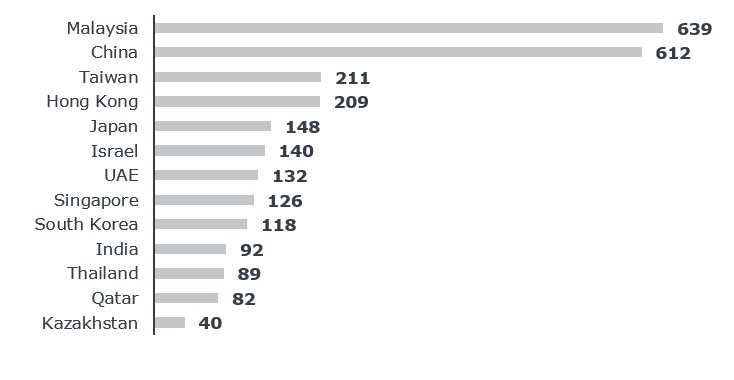This resource provides strategies for attracting online international students, marketing programs internationally, and finding locations for international student recruitment.
850K
Amid the global pandemic, declining support from state and federal governments, and the increasing need for students to be globally competent, colleges and universities in the United States are focused on expanding their student audience beyond domestic enrollments. International students represent a financial and mission-oriented strategy for higher education institutions across the country. However, political controversies in the United States and increased competition for international students globally have recently made this goal much more challenging to achieve.
Executive Overview: Online International Enrollment Efforts Unlikely to Succeed
Online delivery avoids visa challenges and negative attitudes toward living in the U.S. but fails to solve all international enrollment obstacles. Increased competition abroad causes international students to enroll in programs closer to home, especially in the wake of the COVID-19 crisis. As other countries, in addition to domestic institutions, compete for online students, U.S. institutions struggle to find their niche in an over-saturated market, especially at the undergraduate level.
Although professional and adult education programs may experience more success, complex barriers including legal issues, health concerns, high cost, internet accessibility, and language requirements make it difficult for international students to enroll in online programs at U.S. institutions.
Barrier #1: Legal challenges in home countries prevent international students from pursuing online programs from U.S. institutions. Legislation may prohibit or discourage enrollment in online courses, or online courses delivered by international institutions. Additionally, some countries limit access to web content from the United States. Of the top 25 universities by international enrollments, 68 percent had admissions content blocked within China.
Barrier #2: The continued spread of the pandemic in the United States has led to a sharp decline in international student interest in U.S. higher education. While the top five English-speaking countries by number of foreign students all experienced a decline in demand from international students in March 2020, every country apart from the United States recovered demand in the following months. The U.S. also ranked last among English-speaking countries for perceived welfare of international students.
Barrier #3: Countries must meet internet speed requirements for students to access course content. Many countries lack the connection speeds for students to participate in online courses. Online course features such as video conferences and discussion boards require internet speed of at least 10 Mbps.
Barrier #4: Expensive online degree programs reduce access for lower-income students. Wealthy students who could enroll also have the option to choose in-person programs or online programs closer to home, especially at the undergraduate level. Countries with a high gross national income per capita offer institutions the best potential to find audiences able to afford online American tuition. Administrators should consider that students may choose from options that are more prestigious, in-person, or closer to home. If institutions subsidize tuition to expand access, enrolling international students online loses its financial incentive.
Barrier #5: English language proficiency requirements create an additional cost and time barrier to international students. Programs must establish a minimum TOEFL score for students to ensure that students can succeed in their courses. Otherwise, course translation costs would be prohibitively high for institutions to generate revenue from online international enrollments.
Few schools succeed in recruiting and enrolling international students to online programs. Institutions that do well have a combination of three factors: extensive on-ground networks, locally targeted program offerings, and adapted recruitment strategies. While one aspect can primarily fuel institutional success, all three must be present to enroll more than a negligible online international student population.
Characteristic #1: Extensive on-ground networks consisting of religious communities, alumni, or an international association which supports recruitment at scale offer a recruiting edge.
Characteristic #2: Locally targeted program offerings such as veterinary medicine or social justice pique student interest, especially if a nearby institution does not already offer these programs.
Characteristic #3: Adapted recruitment strategies using international social media platforms and customized landing pages for international visitors yield higher returns than one-size-fits-all approaches.
Sizing the International Online Opportunity
As the global pandemic continues to shrink institutional budgets, necessitate remote learning, and create uncertainty in domestic enrollments, higher education leaders may look abroad for new online student audiences. Yet recruiting, enrolling, and serving international students proves difficult for most institutions, especially in the wake of COVID-19.
Asian Countries with English-Taught Programs

StudyPortals, February 2017
n=2,638
Worries over high coronavirus transmissions and visa policy changes have damaged U.S. institutions’ international brand. Competition for international students also increases as more options exist to study at local institutions where students can secure a recognized degree on an accessible campus. For example, over 2,600 English-taught academic programs exist throughout Asia. These programs in Asian countries now compete with each other for international students. This competition spans countries: 440,000 international students attend Chinese institutions, and Malaysia hopes to reach 250,000 international students by 2025. U.S. institutions struggle to compete in this saturated market.
Opportunities for international student recruitment are limited by forces outside of your unit’s control, including relationships with global partners, management of the COVID-19 pandemic, and career paths alumni take.
Before setting new strategies or reallocating investments for international student recruitment, complete the following diagnostic to determine the size of the opportunity at your institution.
If you determine your institution is equipped for online international recruitment, continue reading this white paper and complete the diagnostic on for market selection below.
Characteristics of High-Performing International Online Institutions
Despite the challenges of recruiting students globally, some colleges and universities have managed to successfully enroll large numbers of international students in online programs.
3 qualities of institutions that successfully attract international students

Extensive on-ground networks
- Religious community network
- Large, involved international alumni network International associations

Locally targeted program offerings
- Programs aligned with unique local market demand, and not already filled by institution closer to home, such as civil engineering, social justice, and veterinary medicine.

Adapted recruitment strategies
- International social media platforms
- Online marketing materials
- Customized webpages for international viewers
Characteristic 1: Extensive On-Ground Networks
36

$250K
Creating joint degree programs can be an affordable option for institutions to reach students across the globe without requiring them to come to the United States. Institutions can reserve space at local universities rather than finding a suitable building themselves. Joint degree program partnerships can be beneficial for both the U.S. institution and the host institution; the U.S. institution can expand its reach to international students, while host institutions can leverage their global partnership to boost their image.
The University of Arizona currently operates 36 microcampuses, smaller campuses housed at partner universities. Currently, 13 microcampuses exist with a student capacity of 25,000. The University of Arizona also recently announced a partnership with WeWork to expand this global network in over 490 locations in 80 cities and 37 countries. This partnership will allow students to complete their U.S. degree from the safety of their own country during the global pandemic with wi-fi, space to study, and an in-person community.
The microcampus model also creates a pipeline for international students to enroll in person at the University of Arizona; many international undergraduates who enroll online express interest in attending graduate school on campus at the University of Arizona.
Case Study: University of Arizona Partnership with Ocean University in Quingdao, China
• Emerged out of a five-year-old dual-degree program with Ocean University
• ~$9,000 per year in fees for students – much lower than local universities
• Students also pay tuition at Ocean University
• 98 in 2017, an increase from 77 students the previous year
• $250,000 in new revenue for the University of Arizona in its first year
• 10 percent of students finish their degree at the University of Arizona–Tucson
Religious Institutions Benefit from Existing Networks
Religious institutions can use their pre-existing global networks to recruit international students. Employer partnerships, word-of-mouth marketing, and in-country infrastructure supported by networks allow international students to access online American higher education.
Beyond recruitment, institutions’ religious networks and churches’ reputations can increase experiential learning opportunities, as well as support post-graduate employment through existing corporate relationships.
Administrators at Andrews University and Brigham Young University-Idaho use their church structures to reach and recruit students across the globe, mainly through word-of-mouth marketing. Interested students apply to programs that are financially accessible due to tuition rates highly subsidized by the church.
Promote Programs Through International Associations
Best-practice institutions promote programs through the educational outreach services of international academic and professional associations. Associations such as the Institute of Electrical and Electronics Engineers (IEEE) and the Association for Computing Machinery (ACM) host events in many countries that provide opportunities to meet prospective students, network with potential program advocates, and learn about international trends in the field.
Associations Provide Opportunities for Student Recruitment

Advertising through trade presses and websites

Scholarship programs for prospective students

Referral services that match qualified students to approved institutions
The table below profiles associations in three disciplines identified as high priorities for international audiences: engineering, business, and computer science. These associations were selected based on their large membership, high frequency of events, and extensive education initiatives.
Academic and Professional Associations Provide a Pipeline of Prospective Students
| Engineering | Business | Computer Science | |
| Association | Institute of Electrical and Electronics Engineers (IEEE) | DECA, Inc. | Association for Computing Machinery (ACM) |
| Membership Size | 400,000 members 50 percent of membership from outside the U.S. |
200,000 students of marketing, finance, and management | 100,000 members 200 chapters based in 50 countries |
| Conferences & Events | 1,000+ annual conferences and meetings held around the world | 17,000 members attend the annual International Career Development Conference (ICDC) | 170+ field-specific conferences, workshops, and symposia hosted annually |
| Education Initiatives | Registered Education Providers (REPs) connects international students with IEEE-approved educational programs | Corporate sponsors, institutions, and business organizations award over $300,000 in scholarships annually | Dedicated conferences, committees, and partnerships for promoting global access to quality computing education |
Characteristic 2: Locally Targeted Program Offerings

Online international expansion must consider local programming needs to attract students away from regional competitors. Programs such as livestock health management or global development and social justice may highlight subject matter unavailable at regional institutions but needed locally. Local partners can help identify which topics best fit student needs.
St. John’s University formulated an innovative master’s degree in Global Development and Social Justice to reach international students. While the program is currently offered exclusively online due to the coronavirus crisis, St. John’s University typically offers a hybrid program where international students attend two sessions in Rome, Italy and then finish the rest of the program online in their home countries.
This innovative hybrid approach creates a true sense of community by bringing students together in person for the program’s beginning. Institutions seeking to develop a similar community during the coronavirus crisis could offer multiple synchronous sessions to allow students to connect in real-time despite differences in time zone and country of origin.
The program is accessible to students from all over the world. Current students hail from:
- Brazil
- Canada
- Colombia
- Ghana
- India
- Malawi
- Nigeria
- The Philippines
- The United States
Hybrid Program Extends St. John’s University’s Reach
9
15
18-22
50%
1
1
Characteristic 3: Adapted Recruitment Strategies
U.S.-based social media sites (e.g., Facebook) may not provide the best method of communicating with students in target countries. However, learning country-specific social media proves time consuming for admissions staff. Investing in foreign social media is advisable only if the country presents a viable recruitment market.
The Professional and Adult Education Forum sized the opportunity for international social media in the matrix at right. The size of the professional and adult education market varies based on each institution’s unique offerings (e.g., degree level, discipline). At the suggestion of our partners, the Forum used the number of master’s students in the U.S. as a rough proxy for opportunity size. This is compared to the relative ease of social media entry for staff primarily versed in American social media platforms.
Local Populations with U.S. Social Media Familiarity Make Compelling Cases for Entry

Learn Country-Specific Social Media
Recruitment staff looking to launch a country-specific social media campaign must answer two questions: First, what platforms does the age group of interest use most frequently in the country? And second, what are the user habits and preferences associated with each platform?
Before launching a Chinese social media presence, Brock University conducted an analysis of the relative strengths and weaknesses of different platforms. After this investigation, Brock formulated a plan based on the fact that different Chinese social media platforms are better suited for different purposes.
The University of Wisconsin- Milwaukee recognized the popularity and sheer size of WeChat as an opportunity to connect with prospective Chinese students and parents. Now, after college fairs, one staff member uses the platform to answer questions about the application process, majors offered, visa requirements, etc.
Understand the Audience, Features, and Use of Specific Social Media Channels to Engage International Students
| Audience: What platforms does each age group of interest use most frequently? | Features & Use: What are the user habits and preferences associated with each platform? | |
| All Ages: China’s “app for everything” with over 902 million daily users | Used for everything including: messaging, paying bills, ordering food, hailing cabs, etc. | |
| QQ & Qzone | Under 21: Instant messaging client (QQ) and Facebook style personal pages (Qzone) | Used for call, text, and video (QQ) along with publishing content (Qzone) |
| All Ages: A microblogging platform similar to Twitter | Used to discuss products, culture, and personal topics |
Case Studies: How Schools Use Social Media to Engage Prospective International Students
Brock University’s Plan: Different Channels for Different Purposes
- Uses QQ and Weibo accounts to answer questions and engage in conversations
- Trained student ambassadors answer questions
- Students available during peak activity hours (9-11 AM EDT)
UWM’s Plan: Continue Relationship After College Fairs with Prospective Chinese Students
- Uses WeChat account to connect with prospective Chinese students and parents
- One staff member responds to questions up to a month after college fairs
Customize Online Content for Country of Origin
3x

To connect with international students, program marketing staff should rewrite major headings and topics on webpages to better address their relevance.
Web development staff can build a website that automatically adjusts based on the IP address of the visitor. Best-practice institutions use the location of the internet connection to customize the language and content of the page automatically.
Geo-targeted websites can address:
- Distance to closest satellite campus
- Application requirements
- Required TOEFL scores
- Visa regulations, including ineligibility of online students
- Partnerships that apply to specific countries
- Adjusted tuition and fees in local currency, or at an affordable rate based on the country’s ability to pay
Address Common Concerns and Interests based on Global IP Addresses
Distinct landing page with unique IP Address or pop up window to enter home country
Mention of institution’s international reputation and feature of international enrollment figures
Information on online platform, program costs, admissions requirements, and support services all in one place
Promoted placement of pathways for students from visitor’s location
Appendices
Education First, a global education company, publishes an English Proficiency Index that can inform selection of target countries.
The World Bank offers reliable data on countries’ gross national income per capita (GNI).
Akamai, a cloud delivery platform company, publishes quarterly reports on internet connectivity.
Explore the growing complexity of global engagement in higher education
In this webinar, EAB experts unpack how the changing global landscape is impacting four areas of university operations: Enrollment, research, advancement, and the student experience.